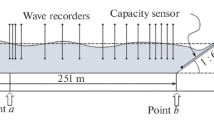Abstract
This article focuses on the effect of frequency dispersion on the wave run-up height and the characteristics of the surface waves reflected from a coastal slope. Calculations are performed within the framework of nonlinear dispersive and nondispersive shallow water models using the original boundary conditions on a moving shoreline. A case study of the problem of solitary wave run-up on flat coastal slopes with parameters close to the characteristics of one of the Kamchatka bays shows that the nondispersive model overestimates the maximum run-up and amplitudes of the reflected waves by 10–20%.





Similar content being viewed by others
REFERENCES
O. I. Gusev, G. S. Khakimzyanov, and L. B. Chubarov, “Numerical Investigation of the Impact of Long Surface Waves on a Partially Submerged Fixed Non-Deformable Structure,"in Nonlinear waves—2021: All-Russian. Conf. with Int. Participation dedicated to the 75th anniversary of Corresponding Member of RAS V. M. Teshukov, Novosibirsk, March 2–4, 2021, p. 27. http://conf.nsc.ru/files/conferences/ nw2021/625257/abstract.pdf.
E. Yu. Kamynin, V. V. Maksimov, I. S. Nudner, et al., “Interaction of a Solitary Wave with a Partially Submerged Fixed Structure," Fund. i Prikl. Gidrofiz., No. 4, 39–54 (2010).
X. Lu and K.-H. Wang, “Modeling a Solitary Wave Interaction with a Fixed Floating Body Using an Integrated Analytical-Numerical Approach," Ocean Engng. 109, 691–704 (2015).
G. S. Khakimzyanov and D. Dutykh, “Long Wave Interaction with a Partially Immersed Body. Pt 1. Mathematical Models," Comm. Comput. Phys. 27 (2), 321–378 (2020).
G. Khakimzyanov, D. Dutykh, Z. Fedotova, and O. Gusev, “Dispersive Shallow Water Waves. Theory, Modeling, and Numerical Methods," (Birkhäuser, Basel, 2020). (Lecture notes in geosystems mathematics and computing).
S. C. Medeiros and S. C. Hagen, “Review of Wetting and Drying Algorithms for Numerical Tidal Flow Models," Intern. J. Numer. Methods Fluids 71, 473–487 (2013).
D. Dutykh, T. Katsaounis, and D. Mitsotakis, “Finite Volume Schemes for Dispersive Wave Propagation and Runup," J. Comput. Phys. 230 (8), 3035–3061 (2011).
F. Shi, J. T. Kirby, J. C. Harris, et al., “A High-Order Adaptive Time-Stepping TVD Solver for Boussinesq Modelling of Breaking Waves and Coastal Inundation," Ocean Model. 43/44, 36–51 (2021).
J. P. A. Pitt, C. Zoppou, and S. G. Roberts, “Solving the Fully Nonlinear Weakly Dispersive Serre Equations for Flows over Dry Beds," Intern. J. Numer. Methods Fluids 93, 24–43 (2021).
V. G. Sudobicher and S. M. Shugrin, “Flow of Water in Dry Channels," Izv. SO AN SSSR. Ser. Tekhn. Nauk 13 (3), 116–122 (1968).
V. M. Lyatkher and A. N. Militeev, “Calculation of the Run-Up of Long Gravitational Waves on a Slope," Oceanology 14 (1), 37–42 (1974).
J. T. Kirby, F. Shi, B. Tehranirad, et al., “Dispersive Tsunami Waves in the Ocean: Model Equations and Sensitivity to Dispersion and Coriolis Effects," Ocean Model. 62, 39–55 (2013).
D. Morichon, V. Roeber, M. Martin-Medina, et al., “Tsunami Impact on a Detached Breakwater: Insights from Two Numerical Models," J. Waterway, Port, Coastal Ocean Engng. 147 (2), 05021001 (2021).
S. L. Gavrilyuk, V. Yu. Liapidevskii, and A. A. Chesnokov, “Spilling Breakers in Shallow Water: Applications to Favre Waves and to the Shoaling and Breaking of Solitary Waves," J. Fluid Mech. 808, 441–468 (2016).
M. Kazakova and G. Richard, “A New Model of Shoaling and Breaking Waves: One-Dimensional Solitary Wave on a Mild Sloping Beach," J. Fluid Mech. 862, 552–591 (2019).
S. P. Bautin, S. L. Deryabin, A. F. Sommer, et al., “Use of Analytic Solutions in the Statement of Difference Boundary Conditions on a Movable Shoreline," Russ. J. Numer. Anal. Math. Model. 26 (4), 353–377 (2011).
Author information
Authors and Affiliations
Corresponding author
Additional information
Translated from Prikladnaya Mekhanika i Tekhnicheskaya Fizika, 2021, Vol. 62, No. 4, pp. 114-123. https://doi.org/10.15372/PMTF20210411.
Rights and permissions
About this article
Cite this article
Gusev, O.I., Khakimzyanov, G.S., Chubarov, L.B. et al. ASSESSING THE FREQUENCY DISPERSION INFLUENCE ON THE SOLITARY-WAVE INTERACTION WITH A CONSTANT SLOPING BEACH. J Appl Mech Tech Phy 62, 624–632 (2021). https://doi.org/10.1134/S0021894421040118
Received:
Revised:
Accepted:
Published:
Issue Date:
DOI: https://doi.org/10.1134/S0021894421040118




